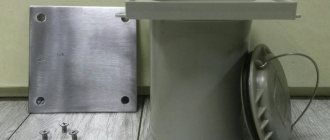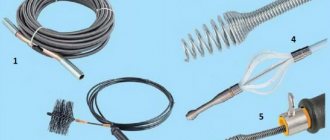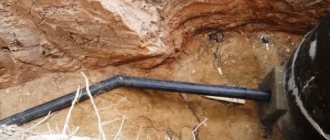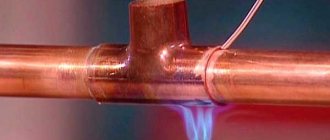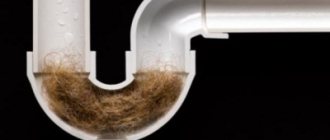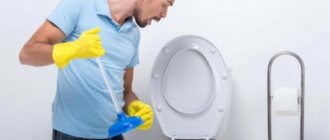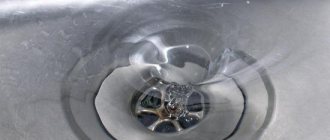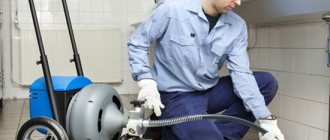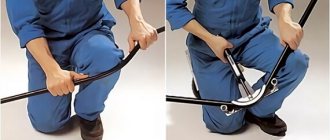Clogged drains are a common occurrence and are encountered regularly. You can eliminate it yourself, without resorting to the services of specialists. There are many ways to clean drains. One of them is the use of hydrochloric acid. The product is aggressive, but effective. Let's consider all the nuances of application and draw a conclusion about the advisability of using this chemical compound.
ATTENTION! A unique, highly effective product has been developed for cleaning sewer pipes, eliminating any blockages. The product is a concentrated mixture of enzymes that easily break down and process fat accumulations and any deposits of organic origin. One package of Saniclean will last you a whole year! Read more"
Where does clogging occur most often?
The kitchen sink always comes first. Residues of fat and food end up in the drain. Even the mesh doesn't help, so watch out when you wash the dishes.
After the kitchen, the most clogged drain is the bathroom drain. Most often this occurs due to a large amount of hair or other debris in the pipe.
But the toilet gets clogged much less often, only when large bags, rags, or personal hygiene products get in the way.
Cleaning methods can be divided into two categories:
- Mechanical. To break through the drain, the following are used: plunger, plumbing cable, brush, wire.
- Chemical. This includes various synthetic products. These can be specialized store-bought formulations or homemade mixtures.
The sink or toilet urgently needs cleaning if the water drains slowly or even stagnates.
Otherwise, it promises trouble. There are some tips on how to get by with “small sacrifices.” That is, look in the drawer, there is soda in there!
Great helper against blockages
Of course, you can call a plumber, he will eliminate this little nuisance. But then you will have to shell out a decent amount. But you can do it on your own.
Sodium bicarbonate is found in every home, but few people know about its use in cleaning pipes.
Advantages of using NaHCO3:
- An affordable product available in every home.
- Low price. Factory-made products are much more expensive than regular baking soda and vinegar.
- Easy to use. Both women and men can cope with this task. The main thing is to keep children away from chemicals.
- This method is suitable for the sink in the bathroom, kitchen, and toilet.
There are many methods for removing clogs with soda. You can pour sodium bicarbonate with vinegar and citric acid. Sometimes mixed with salt, baking soda alone is used.
Recipe 1
What we need:
- First, we clean the drain with a regular rag to remove debris.
- Next, pour a liter of boiling water and wait about half an hour.
- After the time has passed, take a plunger and clean the drain.
- After completing the procedures, use regular baking soda.
- This should be a solution of NaHCO3 and boiling water in a ratio of 1:3.
- Fill in the liquid. We are waiting for several hours. To be on the safe side, you can leave it overnight.
This method is good because the pipes are cleaned and disinfected.
Recipe 2
- sodium bicarbonate (about half a pack);
- 70% vinegar (vinegar essence) – twice as much as sodium bicarbonate or 9% vinegar, then multiply the amount of NaHCO3 by 16.
- Before carrying out the procedure, wash and dry the sink.
- First add sodium bicarbonate, then add vinegar.
- For best results, cover the drain hole with a rag and leave the sink for two hours.
- After the time has passed, rinse the pipe by pouring boiling water into it.
Recipe 3
We use baking soda and vinegar for the toilet. You can use the same solutions that are used to clean the kitchen sink.
But pay attention, it will not be possible to close the hole, so you need to clean the drain carefully. Otherwise, you will have to remove the foam from the floor and do a general cleaning of the room.
Recipe 4
For cleaning, you can use sodium bicarbonate with table salt. Take half a glass of baking soda powder and salt, pour it into the drain, and pour boiling water over it.
Leave the sink for 8-10 hours (it is best to do the procedure at night).
Caustic soda against blockages
This product is not available in every home. They rarely buy it unless absolutely necessary. But if it is available, it will be useful for clearing the blockage.
- caustic soda (2-4 kg);
- water (5-7 l);
- durable plastic bucket;
- plastic spatula or scoop;
- latex or rubber gloves.
- Wear gloves.
- Using a spatula, pour caustic soda into the bucket.
- Fill with water, stir. The crystals should completely dissolve.
- Pour the mixture into the pipe.
During mixing, a chemical reaction occurs, the liquid heats up to approximately 60-70 degrees. This can be intimidating for some people the first time. But believe me, such a reaction is absolutely normal.
Why clean the chimney?
Everyone knows that soot accumulates in the chimney and needs to be cleaned regularly. It's not just about aesthetics. If there is poor draft in the pipe, smoke accumulates there. It contains dozens of toxins and harmful substances, which makes the smoke poisonous. Once in a room, it can penetrate the human respiratory tract and cause various respiratory diseases.
If there is a lot of it and the incident happens at night, there is a risk of dying from suffocation right in your bed. The danger lies not only in this. As it settles on the walls of the chimney, soot sticks firmly to it due to the remaining oil that entered the chimney along with the smoke. Essential oil is found in almost every type of firewood, most of it in coniferous trees.
When fuel is selected taking into account its price, there is no need to talk about quality. An uncleaned chimney heats up the smoke, and the heat can cause soot to ignite. In flakes, burning soot flying out of the chimney can set fire to dry leaves that have fallen onto the roof with the wind or cause fires in wooden buildings that are nearby. Fruit trees in the area may also be damaged.
Over time, the pipe may crack due to high heat. Through the cracks, toxic smoke will enter the attic and enter the house. Saving on chimney cleaning is not a very wise decision. When there is no money, call specialists, you can do the work yourself. One of the methods should help to cope with the problem. If this does not happen, you should not hesitate to call the experts.
Preventing blockages
You can prevent your sink from clogging. Preventive measures are simple. We offer some simple tips (primarily for women and those who wash hamsters' toilets in the sink).
- Take sodium bicarbonate and vinegar in the same proportions as for cleaning pipes. Pour in soda, add acid, turn on hot water.
- Use a sink strainer to prevent food debris, grease, and hair from getting into the drain.
- Make sure that no large waste gets into the drain hole.
Do such procedures once a week, especially in summer. During this period, drains become clogged more often than in winter.
You can also open hot water and let it run a little. This will help avoid pipe blockages.
Some nuances
However, there are factors that must be taken into account when cleaning pipes:
- This may be hazardous to your health. This means caustic soda. Therefore, be sure to follow safety precautions, including gloves and a mask.
- Heavy contamination can take a long time to remove. Very often about 10 hours, sometimes the procedure needs to be repeated several times.
- Before adding soda, make sure that the pipes are strong enough for the procedure, and that the material from which they are made will not deteriorate under the influence of a chemical reaction.
- If you cleaned the pipes with purchased products, then it is prohibited to use sodium bicarbonate and vinegar. This may lead to unexpected reactions. It is better to wait a day so that the store-bought substance has time to wash off.
The most common problem in the kitchen is a clogged sink. It completely paralyzes homework. If you have such a problem, then do not despair and immediately call a plumber. You can try to cope with the problem yourself. Let's look at the ways and means by which this problem is solved.
The importance of regular drain cleaning
When installing a sewerage system, pipes are laid in such a way that cleaning occurs independently. The specialist always calculates the slope of the highways, the speed of water flow, and the angles of bends and turns. In reality, it is not always possible to comply with all the requirements for the location of pipes. Sometimes the system is handled not by professional plumbers, but by home handymen. Therefore, from time to time there is a need to clean the sewer using high pressure.
Over time, deposits of grease and dirt build up on the walls of the pipeline. This happens for several reasons:
- failure to comply with recommended slopes when laying pipes;
- large debris and foreign objects entering the sewer system, causing a blockage to form;
- violation of the hydraulic regime in the system;
- lack of cleaning of the sewer system for a long time.
If you allow small deposits to form on the internal surfaces of pipes, then over time the process of their growth will only intensify. Contamination of the walls leads to a decrease in the throughput of the system. The consequence of this will be complete blockage, and the sewerage system will stop working completely. It becomes impossible to drain water from the sink, sink, bathtub, or toilet. The entire system of treatment facilities is paralyzed.
Blockages and stagnation negatively affect the condition of the pipeline, especially if it is made of cast iron. Harmful bacteria accumulate in the system, which release gases that are hazardous to health and sewer material.
Such accidents lead to the need to dismantle and replace failed pipes. This requires time, effort and money.
It is better to carry out preventive sewer cleanings in advance so that such problems do not arise. To remove blockages, a hydrodynamic sewer flushing machine is used.
Proper cleaning of a sink drain with salt
The simplest remedy for removing blockages is simple table salt, which is available in any household. You will also need hot water for this to work. To deal with the problem, follow this procedure:
- Scoop out any water that has accumulated in the sink;
- pour a glass of salt into the sewer pipe through the drain hole;
- then pour boiling water into it;
- wait 15 minutes and flush the drain with hot water.
Reference! To enhance the effect of salt exposure, add an equal amount of soda. The mixture can also be supplemented with vinegar.
Unfortunately, this method only helps with minor blockages. If the first attempt fails to remove it, repeat the procedure or use more potent methods.
How it works?
Thanks to its wide use in cooking, table salt can always be found in the kitchen cabinet. It not only changes the taste of products, but also has a number of properties useful in the household:
- disinfects;
- absorbs fat, moisture, unpleasant odors;
- When dry, it removes dirt mechanically.
Salt is most effective for cleaning kitchen sinks. But it is also poured into the drain of a bathtub, shower stall, or toilet.
How to properly clean sewer pipes:
- Pour 1 cup of table salt down the sink drain (to clean the toilet with salt, use 2 cups).
- Then pour out 2–3 liters of hot water.
- Wait 15 minutes.
- Rinse with 5 liters of hot water.
Another recipe is used when a blockage occurs. If the water drains very slowly, mix a glass of salt and a glass of baking soda and pour it down the drain. Then add 3-4 tbsp. spoons of vinegar and leave the mixture for 2 hours.
What else can you do to clear the blockage?
In addition to folk remedies, several more methods can be used to clean sewer pipes:
- Mechanical method. To carry it out you will need special tools: a plunger - for surface impact. Its suction cup with intense forward movements helps get rid of small blockages. The second item is a plumbing cable (ruff). One end of it is placed in the drain and, rotating, breaks through the blockage.
- Chemical option. For punching, special means are used: “Mole”, “Tiret”, “Sanflor” and others.
Attention! When using chemicals, do not forget about hand protection - rubber gloves. If the liquid gets on the mucous membranes or in the eyes, rinse the damaged area with plenty of water.
Using a plunger and plumbing cable
When deciding how to clean a sewer pipe, many housewives and owners turn to such a simple and ingenious device as a plunger. It is installed above the drain hole and air is vigorously pumped several times into the sewer. As a result of such mechanical action, the blockage is destroyed. Then you need to turn on the water, which will wash away the remaining accumulated debris.
Before using the plunger, it is recommended to close the overflow hole with a lid or rag. Otherwise, it will not be possible to ensure a sufficiently high air pressure in the system, and the use of a plunger will be ineffective. Sometimes you need to use a plunger several times to achieve the desired result.
A plunger is the most common mechanical means for clearing clogged drains. It must be pressed firmly against the drain hole and pressed vigorously several times.
If the blockage has formed deep in the pipes, a plunger may not be able to remove it. Then the owner of the house will have to arm himself with another popular hand tool - a cable.
A special cable for cleaning sewer pipes is a dense steel spring several meters long. For ease of use, a handle is attached to one end of the cable, and a number of different attachments can be used for the other end.
When cleaning, the cable is lowered into the sewer hole until it reaches the blockage. Then the device begins to rotate in order to mechanically destroy the resulting obstacle.
A sewer cleaning cable is successfully used to remove dirt and debris that has accumulated at a depth of several meters. Attachments allow you to use this device even more effectively.
If maximum force must be applied to remove accumulated contaminants, the cable must be rotated clockwise. If rotated in the opposite direction, the spring may unravel and the cable will be damaged.
Preventing clogs in the sink
Of course, it is possible to eliminate such a nuisance, but it is much easier to prevent its occurrence. To do this, use the following recommendations:
- Use a protective mesh to prevent food debris from entering the sewer pipe.
- Before washing dishes, carefully remove any remaining food from them.
- Do not throw leftover tea into the sink, as this most often causes a blockage.
- Wash dishes only with hot water using fat-dissolving agents.
- Don’t be lazy in the evening after dinner and run hot water down the drain for a few minutes.
- Once a week, carry out the following procedure: pour about five liters of boiling water into the drain hole and use a plunger. Then rinse the drain with clean water.
- Once a month, treat the drain with a mixture of lemon juice, salt and soda. After treatment, rinse the pipes with warm water.
If after a couple of attempts the blockage cannot be removed, do not worry, use the services of specialized services.
Using household items and a few items from your medicine cabinet or kitchen cabinet, you can quickly and easily unclog your kitchen sink without spending a dime. Just select and click below on one of 8 express methods, depending on the degree of blockage, the availability of tools and “chemicals” in the house. Or view the entire material ⇓.
Cleaning a sewer pipe with baking soda and vinegar
Currently, in hardware stores you can find a large assortment of industrial products designed to clear clogs in bathtub drains and kitchen sinks.
However, not all users agree to use aggressive chemicals in their home, preferring safe means at hand. And the main ones are baking soda and table vinegar. These components react with the fat accumulated in the pipes, as a result of which it begins to dissolve. Cleaning drains with soda and vinegar is a simple, reliable and effective method of getting rid of blockages.
First aid for blockages - 6 simple ways
Perhaps, to clear the blockage in your kitchen sink, the following simple and absolutely harmless to pipes (of any kind) steps will be enough, and you will not need to read further this article.
Method 1. Cleaning pipes with boiling water or hot water
Perhaps this is the very first aid measure, which is often enough to clear blockages.
- If the pipes are steel, pour about 1 liter of boiling water into the drain hole and wait 20 minutes. To clean plastic pipes, simply run hot water from the tap for about 20 minutes (the water temperature should not exceed 60 degrees). A plug that is not too tightly seated should drain into the sewer.
- We check the result by running a small stream of water. Did not help? Let's try another method.
Important
There is one more important point.
Acid is poured into the plumbing drain hole. If there is water in the siphon, the concentration will drop sharply and the expected result will not be obtained. If you remove water before flushing the sewer with hydrochloric acid, the composition will only pass through the lower part of the pipelines. Proponents of sewer cleaning using similar methods proceed from general ideas about the properties of materials. They do not take into account the multiple factors that reduce the effectiveness of the composition. Hydrochloric acid for drain cleaning gives the desired effect only at a fairly high concentration.
However, it is easier to disassemble and perform mechanical cleaning. It will take much less time and will not require noticeable effort.
You may also like:
How to clean the drain and remove the blockage with your own hands
Cleaning sewer wells: methods and techniques
When traditional methods don't help
Problem not solved? If first aid does not help, this means that the clog in the sink is old, large and dense. How to clear a blockage in a pipe if traditional recipes do not work? Don’t rush to call a plumber and disassemble the siphon; try using special chemicals (Mole, Tiret, Pothan, etc.) or a plumbing cable.
Method 7. How to clear a clogged pipe using a plumbing cable (and how to replace it at home)
If the kitchen sink is very clogged, you can use a special plumbing cable. This metal device looks like a brush with a long flexible handle (sold in hardware stores). Cleaning water pipes with a cable is best suited for metal structures - it can even partially remove rust. But the method is not suitable for cleaning plastic pipes, since there is a risk of damaging them due to excessive mechanical pressure.
- The cable is placed in the pipe and rotated. Here you can direct the movement both away from you, pushing the blockage into the sewer pipe, and towards you, pulling out the plug.
- When cleaning with a cable, you need to periodically supply water to the sink so that the flow of water washes away the released dirt.
- Run hot water for a few minutes to flush any remaining sediment down the drain.
- If there is no cable on the household, then an ordinary metal hanger will come to the rescue, from which you can make a mini cable. Cut it with wire cutters so that the resulting wire has a small hook at the end (see picture below).
Method 8. How to clear a clog in the sink using household chemicals
Special products designed to remove blockages in pipes can be acidic or alkaline. Most often they are:
- Liquid and helium (for example, Sanfor, Tiret Turbo, Deboucher).
- Dry in the form of loose powder or granules (for example, Bagi Pothan, Mole, Chirton “Clean Drains”).
The pipe cleaner is selected depending on the material of the water pipe and the expected type of contamination.
- The cheapest, well-known and universal remedy is “Mole”, which is based on acidic compounds and in most cases corrodes blockages of any origin. But for the most advanced cases, we recommend trying the fast-acting remedy Bagi Pothan in the form of granular powder.
- Liquid cleaners for clearing clogs are gentler and easier to use.
- Whatever remedy you choose, first clear the blockage with boiling water for 20 minutes (if the pipes are steel) or with a stream of hot water for 20 minutes (if the pipes are plastic). Then add the cleaning solution exactly following the manufacturer's instructions.
- If children live in the house, then it is better to buy a pipe cleaner for one time in small packages.
- Before you start cleaning your pipes, be sure to wear rubber gloves, otherwise the clog remover will attack not only the stopper, but also your skin.
- If you are planning to clear a clog in your sink using a caustic chemical or vinegar, be sure to open the window.
Equipment for sewer cleaning using the hydrodynamic method
When cleaning the pipeline, a hydrodynamic machine is used. It consists of the following structural elements:
- compressor for creating pressure;
- water tank;
- flexible hose for cleaning pipes;
- a nozzle for a hose, which consists of nozzles for supplying water and a fastening element.
There are other details as well. These include filters, water pressure regulators, and a wheelbase to transport the unit around the site. The kit also includes accessories for cleaning the nozzles after use.
The set contains several types of nozzles through which water is directed under pressure towards the contaminants. Which one to use depends on the volume of growths and the nature of the blockages. Examples of nozzles:
- Universal (reactive) . Refers to the standard options, it does not have a nozzle at the front. Used to get rid of small plugs and flush pipes.
- Punchy . This type is standard shaped with a front nozzle. Excellent for removing large plugs of debris, grease, and ice.
- Donnaya . It has a wedge shape. Suitable for washing the bottom of the channel from silt deposits.
- Chain . These nozzles are produced in several forms - triangular, spiral, toothed. They consist of 4 nozzles that are directed forward. Used to break apart large hardened plugs.
- Corner . Flexible nozzle, which consists of several links. Used for cleaning sewer systems of complex configurations and siphons.
- Rotary-vibration . Complex attachment with a shifted center of gravity. It has a rotating part. Suitable for removing stone deposits and other difficult cases.
How to disassemble and clean the sink siphon - the simplest and most reliable way to remove a blockage
If you have already tried to break through the blockage in the sink using folk or chemical remedies, but the water still stands or drains slowly, then most likely you need to clean the siphon. Fortunately, even a child can take it apart. All you need is: 15 minutes of free time and a screwdriver or coin.
Step 1. Unscrew the nut that is located above the siphon reservoir and carefully remove it.
- It is advisable, before disassembling the siphon, to place a basin under it for occasional puddles and to collect dirt. And, of course, don't forget to wear rubber gloves.
Step 2. Hold the siphon in one hand, and with the other hand disconnect the drain hose, unscrewing the nut between them. Next, we move the siphon and drain hose to the side (for example, into a basin), and at the same time remove the dirt that falls out of them.
Step 3. Now unscrew the drain grate in the sink using a screwdriver or coin (most modern grates can be unscrewed with a coin).
Step 4. Unscrew the top nut on the remaining pipe and take it out of the sink along with the already unscrewed drain grate. Hooray! The siphon is disassembled.
Step 5. Wash all the parts. To thoroughly clean the siphon, unscrew the flask from it.
Step 6. We assemble the siphon in the reverse order: install the drain grate and pipe, secure it with a nut, then assemble the siphon, connect it to the drain hose and, finally, screw it to the pipe. Ready! We check whether the blockage has been cleared and are proud of ourselves.
Recommendations for cleaning plastic pipes
Cleaning plastic pipes should be done with extreme caution, since the material is quite susceptible to mechanical damage. It is worth knowing that the smooth surface of plastic pipes does not corrode. Also, surface contaminants do not adhere well to it. However, a blockage can still occur, because fat deposits, hair, and food debris gradually clog the water drain.
- For plastic pipes, you can use a plunger or household chemicals, which give excellent results.
Question answer
How to clear a clog with a cable?
If you have already tried all the methods for removing blockages and even disassembled the siphon, but the problem has not been solved, then this means that the blockage has formed in the drain pipe, and not in the siphon or hose. This does not happen often and only in old houses. In this case, the only way out is to clean the pipe with a plumbing cable or call a plumber. In fact, it's not difficult at all. From this video you can learn in detail how to clear a clog with a cable.
What measures to prevent blockages should be taken?
To keep your kitchen pipes from getting clogged for as long as possible, you should follow these recommendations:
- A clogged kitchen sink is a normal and inevitable problem for any home, but it is better to prevent its occurrence for as long as possible and carry out preventive measures in a timely manner. After all, the more often we clean the pipes, the faster and easier the blockages are removed, and the pipes and siphon do not wear out. Just get into the habit of running hot water or pouring boiling water down your sink drain for 20 minutes every week, or cleaning out your plumbing with a plunger.
- Try not to pour liquids containing cooking oil into the kitchen sink, as it hardens in the pipes/siphon and causes deposits to build up on the walls of the water supply. If this happens, immediately take preventive measures - run hot water/boiling water or pour soda and salt into the drain (see Method 3).
- Of course, all dishes should be cleared of food debris before washing in the sink. Most often, the cause of blockages lies in our laziness.
